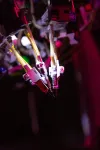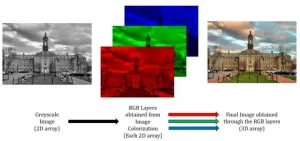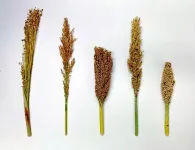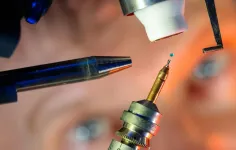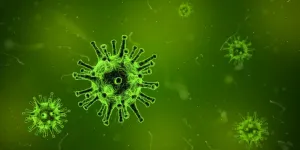(Press-News.org) A new study from researchers at the Allen Institute collected and analyzed the largest single dataset of neurons' electrical activity to glean principles of how we perceive the visual world around us. The study, published Wednesday in the journal Nature, captures the hundreds of split-second electrical signals that fire when an animal is interpreting what it sees.
Your brain processes the world around you nearly instantaneously, but there are numerous lightning-fast steps between light hitting your retinas and the point at which you become aware of what's in front of you. Humans have three dozen different brain areas responsible for understanding the visual world, and scientists still don't know many of the details of how that process works.
"At a very high level, we want to understand why we need to have multiple visual areas in our brain in the first place," said Josh Siegle, Ph.D., Assistant Investigator in the Allen Institute's MindScope Program. "How are each of these areas specialized, and then how do they communicate with each other and synchronize their activity to effectively guide your interactions with the world?"
In the new study, Siegle and other MindScope researchers Xiaoxuan Jia, Ph.D., Senior Scientist; Shawn Olsen, Ph.D., Associate Investigator; and Christof Koch, Ph.D., Chief Scientist led a team of researchers to pin down some of those details.
The Allen Institute team turned to the mouse, whose lima-bean-sized brain is still incredibly complicated. Mouse vision is not the same as ours -- for one, they rely more heavily on other senses than we do -- but neuroscientists believe they can still learn many general principles about sensory processing from studying these animals.
Using Neuropixels, high-resolution silicon probes thinner than a human hair that read out activity from hundreds of neurons at once, the team built a public dataset of electrical spikes from approximately 100,000 neurons in the mouse brain.
Not only is this dataset the largest collection of neurons' electrical activity in the world, but each experiment in the database captured information from hundreds of brain cells from up to eight different visual regions of the brain at once. Reading electrical activity simultaneously across different areas of the brain allowed the scientists to trace visual signals in real-time as they passed from the mouse's eyes to higher regions of its brain.
The researchers found that visual information travels along a "hierarchy" through the brain, in which lower areas represent simpler visual concepts like light and dark, while neurons at the top of the hierarchy are capturing more complex ideas, like the shape of objects.
"Historically, people have studied one brain region at a time, but the brain doesn't mediate behavior and cognition with just one area alone," said Olsen. "We're learning that the brain operates through the interaction of areas and signals sent from one area to another, but technical limitations have prevented us from studying this in depth in the past. We really needed the integrated view that this dataset provides to start to understand how that works."
Tracing the brain's traffic patterns
The Neuropixels study built off a previous Allen Institute study that mapped the mouse brain's wiring diagram, the physical connections made by bundles of axons between many different areas of the brain. With data from the Allen Mouse Brain Connectivity Atlas, that study traced thousands of connections within and between the thalamus and cortex, the outermost shell of the mammalian brain that is responsible for higher level functions, including processing the visual world.
If the connectivity data is like the brain's road map, the Neuropixels dataset is akin to tracking traffic patterns in the brain, Koch said. Even though signals in the brain move in a split second from one region to the next, the probes are sensitive enough to detect very slight time delays that let the scientists draw a real-time map of the route visual information takes in the brain. By comparing the Neuropixels data with the connectivity data, the scientists can get a clearer picture of how information moves along neural roadways.
"It's as if we're trying to map how cities are connected by watching the movement of cars on the road," Koch said. "If we see a car in Seattle and then a few hours later we see that same car in Spokane and then much later we see the car in Minneapolis, then we have an idea that the connection from Seattle to Minneapolis has to pass through Spokane on the way."
Like the roads in a country, the wiring map of a brain is not a simple structure. There are many different, parallel connections between two brain areas, even two neighboring areas. And like our system of interstate highways, arterial roads, and smaller roads, the brain has stronger and weaker connections. Just knowing the physical map isn't enough to predict the route of visual information.
The researchers were able to map the signals onto a hierarchy using the time delays they observed in neural activity between different brain regions. They also used other measures to confirm the hierarchy, including the size of visual field each neuron responds to. Cells lower in the hierarchy are tuned to smaller portions of the animal's visual world, while the higher-level neurons react to larger regions of visual space, presumably because those cells are integrating more information about an entire picture in front of the animal.
A critical process
The scientists captured neural activity both when animals were viewing different photos and simple images, and in mice trained to respond to an image change in front of their eyes by licking a tiny waterspout. They saw that information traveled in the brain across the same hierarchical path in both situations. When mice were trained to respond to a visual change, their visual neurons also altered their activity, and those cells higher in the hierarchy showed even larger changes.
The scientists could even tell just from looking at the neural activity whether or not a particular animal had successfully detected a change in the image.
And if the researchers turned out all the lights -- giving the animals no visual input -- many of the same visual neurons still fired, albeit more slowly, but the order of information flow was lost. This could mean that the hierarchy is needed to process visual information, but the animals use the same cells for other purposes in a different circuit.
Although these kinds of detailed experiments are not possible in humans, studies looking at general brain activity have seen a similar sort of hierarchy -- and changes in brain activity -- in the parts of our brains responsible for sound and visual processing. Neuroscientists believe this type of hierarchical processing is used throughout the brain to understand many aspects of the world around us, not just what we see.
"We know that our ability to create coherent representations of objects we are seeing is a critical process for survival. Our brains have actually designated around 30 to 50% of the cortex just for visual processing," Jia said. "Our study suggests that this hierarchical processing of visual information is also meaningful or important for the animal."
INFORMATION:
Various software packages can be used to evaluate products and predict failure; however, these packages are extremely computationally intensive and take a significant amount of time to produce a solution. Quicker solutions mean less accurate results.
To combat this issue, a team of Penn State researchers studied the use of machine learning and image colorization algorithms to ease computational load, maintain accuracy, reduce time and predict strain fields for porous materials. They published their work in the Journal of Computational Materials Science with accompanying presentations and proceedings in Procedia Engineering.
"There is always a human side to design," said Chris McComb, assistant professor of engineering design in the School of Engineering Design, ...
ITHACA, N.Y. - When humans first domesticated maize some 9,000 years ago, those early breeding efforts led to an increase in harmful mutations to the crop's genome compared to their wild relatives, which more recent modern breeding has helped to correct.
A new comparative study investigates whether the same patterns found in maize occurred in sorghum, a gluten-free grain grown for both livestock and human consumption. The researchers were surprised to find the opposite is true: Harmful mutations in sorghum landraces (early domesticated crops) actually decreased compared to their wild relatives.
The ...
Harbor porpoises have rebounded in a big way off California. Their populations have recovered dramatically since the end of state set-gillnet fisheries that years ago entangled and killed them in the nearshore waters they frequent. These coastal set-gillnet fisheries are distinct from federally-managed offshore drift-gillnet fisheries. They have been prohibited in inshore state waters for more than a decade. The new research indicates that the coastal set gillnets had taken a greater toll on harbor porpoise than previously realized.
The return of harbor porpoises reflects the first documented example of the species rebounding. It's a bright spot for marine wildlife, the scientists write in a new assessment published in Marine Mammal Science.
"This is ...
A new study shows that humans express a powerful hormone during exercise and that treating mice with the hormone improves physical performance, capacity and fitness. Researchers say the findings present new possibilities for addressing age-related physical decline.
The research, published on Wednesday in Nature Communications, reveals a detailed look at how the mitochondrial genome encodes instructions for regulating physical capacity, performance and metabolism during aging and may be able to increase healthy lifespan.
"Mitochondria are known as the cell's energy source, but they are also hubs that coordinate and fine-tune metabolism by actively communicating to the rest of the body," said Changhan David Lee, assistant professor at the USC Leonard Davis School of Gerontology ...
BOSTON - Opioid addiction is persistently stigmatized, delaying and preventing treatment for many - an urgent problem with overdose deaths continuing to rise. To help alleviate this, various medical ways of describing opioid-related impairment, such as "a chronically relapsing brain disease," "illness," or "disorder," have been promoted in diagnostic systems and among national health agencies.
"While intensely debated, there were no rigorous scientific studies out there to inform practice and policy about which terms may be most helpful in reducing stigma," says John F. Kelly, PhD, lead investigator ...
Two novel techniques, atomic-resolution real-time video and conical carbon nanotube confinement, allow researchers to view never-before-seen details about crystal formation. The observations confirm theoretical predictions about how salt crystals form and could inform general theories about the way in which crystal formation produces different ordered structures from an otherwise disordered chemical mixture.
Crystals include many familiar things, such as snowflakes, salt grains and even diamonds. They are regular and repeating arrangements of constituent molecules that grow from a chaotic sea of those molecules. ...
Researchers from King's College London have shown that whole body magnetic resonance imaging (WBMRI) not only detects more myeloma-defining disease than positron emission tomography/computed tomography (PET/CT) with 18F-fluorodeoxyglucose (FDG) but that it also allows critical treatment to be initiated earlier.
In a study published today in the European Journal of Nuclear Medicine and Molecular Imaging, researchers looked at 46 patients with suspected myeloma, a debilitating bone marrow cancer which sees 140,000 new cases each year globally.
Less than 50 percent of patients survive after five years and at present it is not clear which is the best imaging ...
"Such reactions are usually carried out using transition metals, such as nickel or iridium," explains Prof. Robert Kretschmer, Junior Professor of Inorganic Chemistry at the University of Jena, whose work has been published in the prestigious Journal of the American Chemical Society. "However, transition metals are expensive and harmful to the environment, both when they are mined and when they are used. Therefore, we are trying to find better alternatives." That two metals can do more than one is already known in the case of transition metals. "However, there has been hardly ...
Viral respiratory diseases are easily transmissible and can spread rapidly across the globe, causing significant damage. The ongoing covid-19 pandemic is a testament to this. In the past too, other viruses have caused massive respiratory disease outbreaks: for example, a subtype of the influenza virus, the type A H1N1 virus, was responsible for the Spanish flu and the Swine flu outbreaks. Thus, to prevent such health crises in the future, timely and accurate diagnosis of these viruses is crucial. This is exactly what researchers from Korea have attempted to work toward, in their brand-new study. Read on to understand how!
For several decades now, polymerase chain reaction (PCR)-based assays have been the gold standard for detecting influenza viruses. And while these ...
An international study coordinated by the Research Group for Urban Nature and Biosystems Engineering (NATURIB) from the University of Seville's School of Agricultural Engineering emphasises that having plants at home had a positive influence on the psychological well-being of the dwelling's inhabitants during COVID-19 lockdown. Researchers from the Hellenic Mediterranean University (Greece), the Federal Rural University of Pernambuco (Brazil) and the University of Genoa (Italy) participated in the study along with representatives from the University ...
